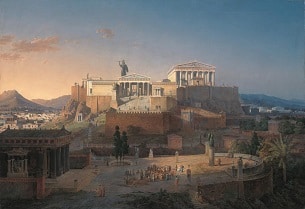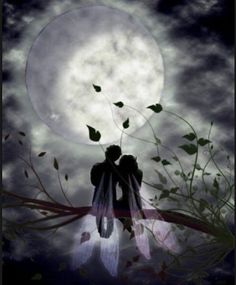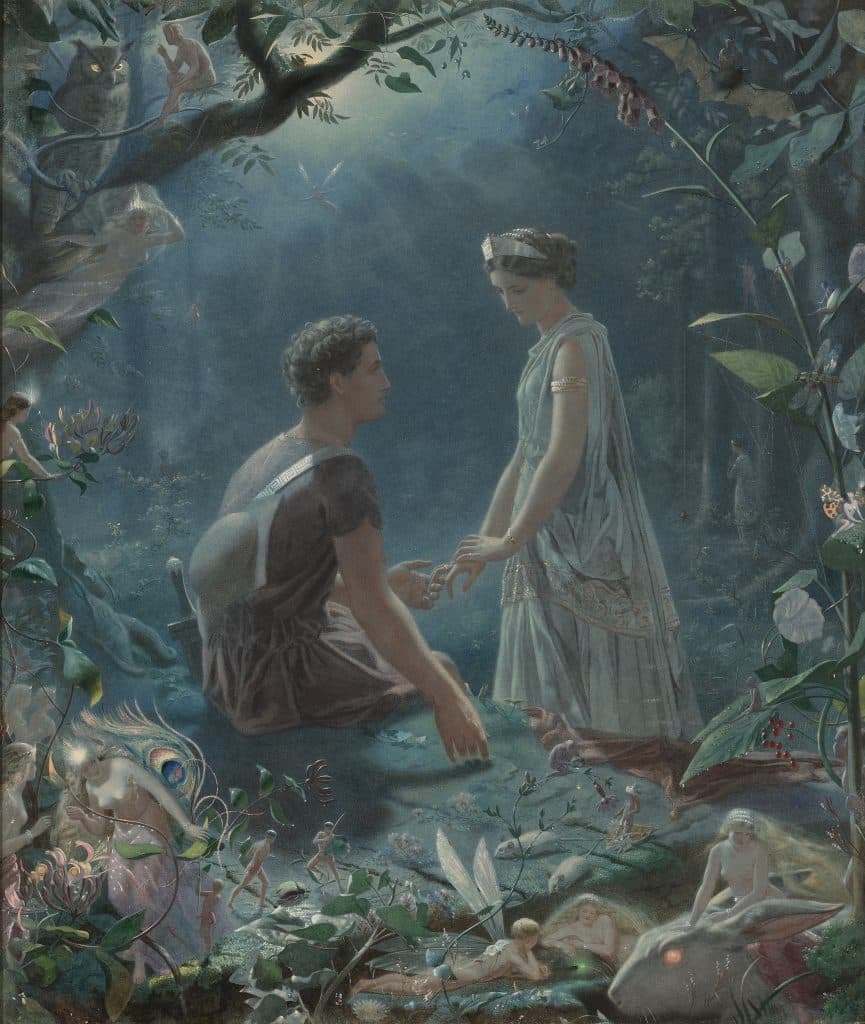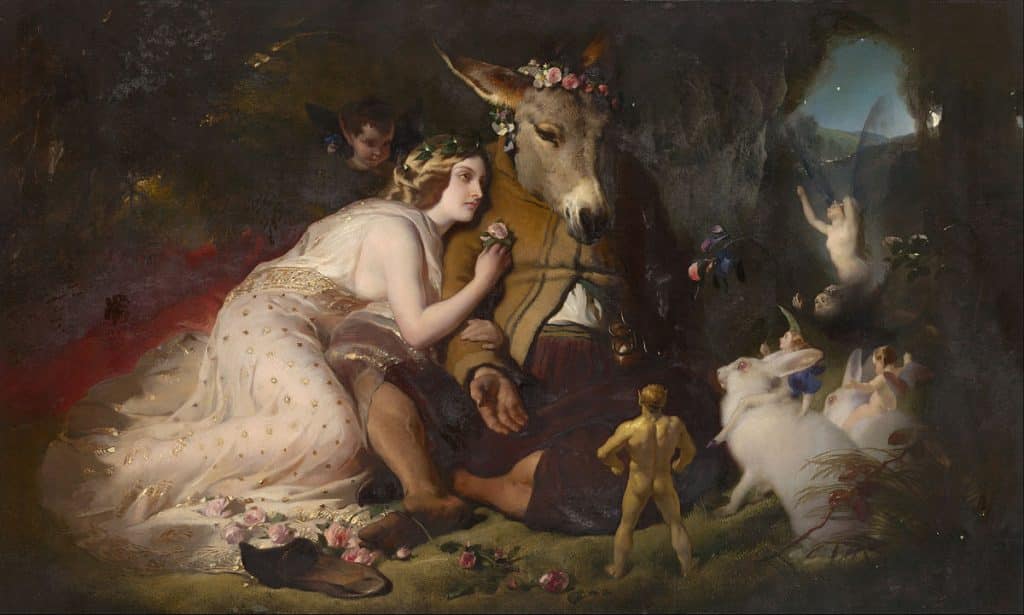One of William Shakespeare’s most notable comedies is “A Midsummer Night’s Dream.” According to Harold Bloom, “Nothing by Shakespeare before A Midsummer Night’s Dream is it’s equal, and in some respects nothing by him afterwards surpasses it. It is his first undoubted masterwork, without flaw, and one of his dozen or so plays of overwhelming originality and power.” [1]
This play is organized around two geographical places: Athens and the wilderness around Athens. The woodland comes to life thanks to fairies who orchestrate the action, transforming it into the enchanted realm of the play. This comedy is also divided into five acts, and the action takes place at two different times: day and night. The first act happens in the daytime; the second and third acts are in the nighttime, the fourth act and the fifth act alternate between day and night.
Shakespeare’s play, according to Montrose, is Elizabethan in two ways: on the one hand, it represents that period’s culture, and on the other, it serves to produce it: “The play is a creation of Elizabethan culture, increasing the dimensions of the cultural field and modifying lines from inside.” [2] The first act takes place in Athens, where preparations for the upcoming wedding of Theseus, the duke, and Hippolyta, queen of the Amazons, are ongoing. The two lovers talk, and the duke assures himself that he will marry her: “with pomp, with triumph, and with revelling”.
Egeus, an Athenian, interrupts the two’s conversation because he is upset with his daughter, Hermia, who does not want to marry the young Demetrius whom he had chosen and accuses Lysander of stealing his daughter’s heart with the songs he dedicated to her in the middle of the night.
The Moon
The moon, an important symbol in the play, appears here, and it has a strong influence on many of the characters, impacting the way they act. It is related to the characters’ experiences with love and dreams. The play’s action takes place at night when the moon rules. The moon also appears during the weddings of Theseus and Hippolyta, as well as the other two couples.
This is evident in the two’s discussion when Theseus states that the aged moon slows time (‘Another moon. But, O, methinks how slow This old moon wanes! She lingers my desires.’ [3]) and also when Egeus describes how Lysander took his daughter’s heart, the moon appears as well: “Thou hast by moonlight at her window sung/With feigning voice verses of feigning love/ And stol’n the impression of her fantasy”. [4]
Hermia and Lysander, those two young individuals, wish to leave Athens and tell Helena, a young lady who was friends with Hermia, about their plan. Helena, hoping to gain Demetrius’ favour, informs him where his future bride is and accompanies him to the forest, where he searches for Hermia. The scene shifts to a forest near Athens in the second and third acts, where fairies who came for Theseus’ wedding are present.
Through the utilization of magic, fairies, and the interpenetration of dreams, woodland mysticism serves as a bridge between the actual world and the dream realm. There will be events that defy nature’s and Athena’s rules.
Flowers
Oberon, the fairy king, has a disagreement with his queen, Titania, and tells his attendant Puck to fetch him a red flower on which Cupid’s arrow has fallen. As a result, another significant motif of the work, the flower, is introduced. The flower is associated with the woods. It contains a magical liquid that, when applied to a person’s eyelids, allows that person to instantly fall in love with whichever creature they see upon awakening. The other white flower is used to undo the first bloom’s magical enchantments.
Flowers, therefore, reflect both nature and the wild yet ultimately a beneficent aspect of fairy power. His purpose is to punish her for disrespecting him by forcing her to fall passionately in love with whichever person or thing she chances to see when she wakes up. Noticing that the woodland lovers are also at odds, he instructs Puck to pour love juice into Demetrius’ eyes, restoring Demetrius’ special affinity for Helena. However, because the two young Athenians are so similar, Puck unintentionally gives the love juice to Lysander, who subsequently sees Helena when he wakes up. Both young individuals are now in love with Helena, but this circumstance does not make her happy. She decides that everyone is making fun of her, including Hermia.
A group of artists recreates a celebration for the duke’s wedding in the same woodland. Puck, who is always amusing, provides one of the “mechanics,” Nick Bottom, a donkey head. When Titania awakens, she falls in love with Bottom and lavishes him with presents, promising that the fairies would look after him as well. Oberon’s wizardry restores Titania and the four lovers to their original conditions after much general bewilderment and comedic misunderstanding. Duke Theseus and his companions find the youths towards the close of the fourth act, and seeing how much they love each other, he tells them that they will marry him simultaneously.
The scenery changes again in the final act at Theseus’s Castle in Athens, where all three marriages occur. Theseus’ wife has some reservations about the events recounted by the four young men. Still, she also feels they would not have known so many details if they were not genuine. Bottom’s band performs a humorously bad rendition of their play, The Most Lamentable Comedy and Cruel Death of Pyramus and Thisbe, which turns out to be a satire of the terrible adventures the lovers have survived in the forest.
As a result, this play depicts a multitude of universes that collide and vary based on imagination. It reveals two illogical realms in the universe: The court of Athens with the ordinary mortals in the spell of love and beyond the boundaries of space-time or any other human existential detail, the realm of fairies. The two places where the action occurs merge beautifully and accentuate the order.
The forest gives an escape from the realities of marriage limitations and rulers in the patriarchal culture of the period. Therefore, the forest provides a space for nocturnal play. Harold Bloom outlines that “Shakespeare uniquely took pains to work out a fairly elaborate and outrageous plot for A Midsummer Night’s Dream.[5]
[1] Bloom, Harold. Shakespeare The Invention of the Human., 1998, page 172
[2] Montrose, Louis. The purpose of Playing, Shakespeare and the Cultural Politics of the Elizabethan Theatre
[3]Stanley Welles, Taylor Gary, The Oxford Shakespeare- The Complete Works, Oxford University Press 1986
[4] Stanley Welles, Taylor Gary, The Oxford Shakespeare- The Complete Works, Oxford University Press 1986
[5]Bloom, Harold. Shakespeare The Invention of the Human., 1998, page 173




